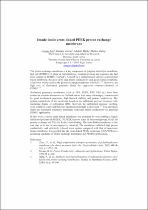JavaScript is disabled for your browser. Some features of this site may not work without it.
- ResearchSpace
- →
- Research Publications/Outputs
- →
- Conference Publications
- →
- View Item
| dc.contributor.author |
Luo, H

|
|
| dc.contributor.author |
Vaivars, G

|
|
| dc.contributor.author |
Mathe, Mahlanyane K

|
|
| dc.contributor.author |
Zheng, Haitao

|
|
| dc.date.accessioned | 2010-03-26T08:58:33Z | |
| dc.date.available | 2010-03-26T08:58:33Z | |
| dc.date.issued | 2009-08 | |
| dc.identifier.citation | Luo, H, Vaivars, G et al. 2009. Imade-imide cross-linked PEEK proton exchange membrane. 60th Annual Meeting of the International Society of Electrochemistry, Beijing, China, 16-21 August 2009, pp 1 | en |
| dc.identifier.uri | http://hdl.handle.net/10204/4003 | |
| dc.description | 60th Annual Meeting of the International Society of Electrochemistry, Beijing, China, 16-21 August 2009 | en |
| dc.description.abstract | The proton exchange membrane is a key component of polymer electrolyte membrane fuel cell (PEMFC). It plays an important role, conducts protons and separates the fuel from oxidant in PEMFC. DuPont’s Nafion is a perfluorinated sulfonic acid polymer based membrane. Because of its high proton conductivity and good chemical stability, it has been widely used as the proton exchange membrane in PEMFC. However, the high cost of fluorinated polymers limits the large-scale commercialization of PEMFC. Sulfonated polymeric membranes (such as PEK, PEEK, PSU, PES etc.) have been studied as potential alternatives to Nafion due to their many advantages, characterised by good mechanical properties, high thermal stability and proton conductivity. The proton conductivity of the membrane based on the sulfonated polymer increases with increasing degree of sulfonation (DS). However, the sulfonation increase swelling, even soluble in water and therefore mechanical strength is decreased. This drawback limits the sulfonated polymeric membrane with high proton conductivity for practical PEMFC application. In this work, a novel cross-linked membrane was prepared by cross-linking a highly sulfonated polymer (SAPEEK). SAPEEK has two types of functional groups, SO3H for proton exchange and NH2 for further cross-linking. The cross-linked membrane is low cost due to its use of non-expensive chemical. The membrane exhibited high proton conductivity, and extremely reduced water uptake compared with that of non crosslinked membrane. It suggested that the cross-linked PEEK membrane (CSAPEEK) is a promising candidate of proton exchange membranes for PEMFC applications. | en |
| dc.language.iso | en | en |
| dc.subject | Polymer electrolyte membrane fuel cell | en |
| dc.subject | PEMFC | en |
| dc.subject | Fuel cell | en |
| dc.subject | Proton conductivity | en |
| dc.subject | Sulfonated polymeric membranes | en |
| dc.subject | Nafion | en |
| dc.title | Imade-imide cross-linked PEEK proton exchange membrane. | en |
| dc.type | Conference Presentation | en |
| dc.identifier.apacitation | Luo, H., Vaivars, G., Mathe, M. K., & Zheng, H. (2009). Imade-imide cross-linked PEEK proton exchange membrane. http://hdl.handle.net/10204/4003 | en_ZA |
| dc.identifier.chicagocitation | Luo, H, G Vaivars, Mahlanyane K Mathe, and Haitao Zheng. "Imade-imide cross-linked PEEK proton exchange membrane." (2009): http://hdl.handle.net/10204/4003 | en_ZA |
| dc.identifier.vancouvercitation | Luo H, Vaivars G, Mathe MK, Zheng H, Imade-imide cross-linked PEEK proton exchange membrane; 2009. http://hdl.handle.net/10204/4003 . | en_ZA |
| dc.identifier.ris | TY - Conference Presentation AU - Luo, H AU - Vaivars, G AU - Mathe, Mahlanyane K AU - Zheng, Haitao AB - The proton exchange membrane is a key component of polymer electrolyte membrane fuel cell (PEMFC). It plays an important role, conducts protons and separates the fuel from oxidant in PEMFC. DuPont’s Nafion is a perfluorinated sulfonic acid polymer based membrane. Because of its high proton conductivity and good chemical stability, it has been widely used as the proton exchange membrane in PEMFC. However, the high cost of fluorinated polymers limits the large-scale commercialization of PEMFC. Sulfonated polymeric membranes (such as PEK, PEEK, PSU, PES etc.) have been studied as potential alternatives to Nafion due to their many advantages, characterised by good mechanical properties, high thermal stability and proton conductivity. The proton conductivity of the membrane based on the sulfonated polymer increases with increasing degree of sulfonation (DS). However, the sulfonation increase swelling, even soluble in water and therefore mechanical strength is decreased. This drawback limits the sulfonated polymeric membrane with high proton conductivity for practical PEMFC application. In this work, a novel cross-linked membrane was prepared by cross-linking a highly sulfonated polymer (SAPEEK). SAPEEK has two types of functional groups, SO3H for proton exchange and NH2 for further cross-linking. The cross-linked membrane is low cost due to its use of non-expensive chemical. The membrane exhibited high proton conductivity, and extremely reduced water uptake compared with that of non crosslinked membrane. It suggested that the cross-linked PEEK membrane (CSAPEEK) is a promising candidate of proton exchange membranes for PEMFC applications. DA - 2009-08 DB - ResearchSpace DP - CSIR KW - Polymer electrolyte membrane fuel cell KW - PEMFC KW - Fuel cell KW - Proton conductivity KW - Sulfonated polymeric membranes KW - Nafion LK - https://researchspace.csir.co.za PY - 2009 T1 - Imade-imide cross-linked PEEK proton exchange membrane TI - Imade-imide cross-linked PEEK proton exchange membrane UR - http://hdl.handle.net/10204/4003 ER - | en_ZA |






